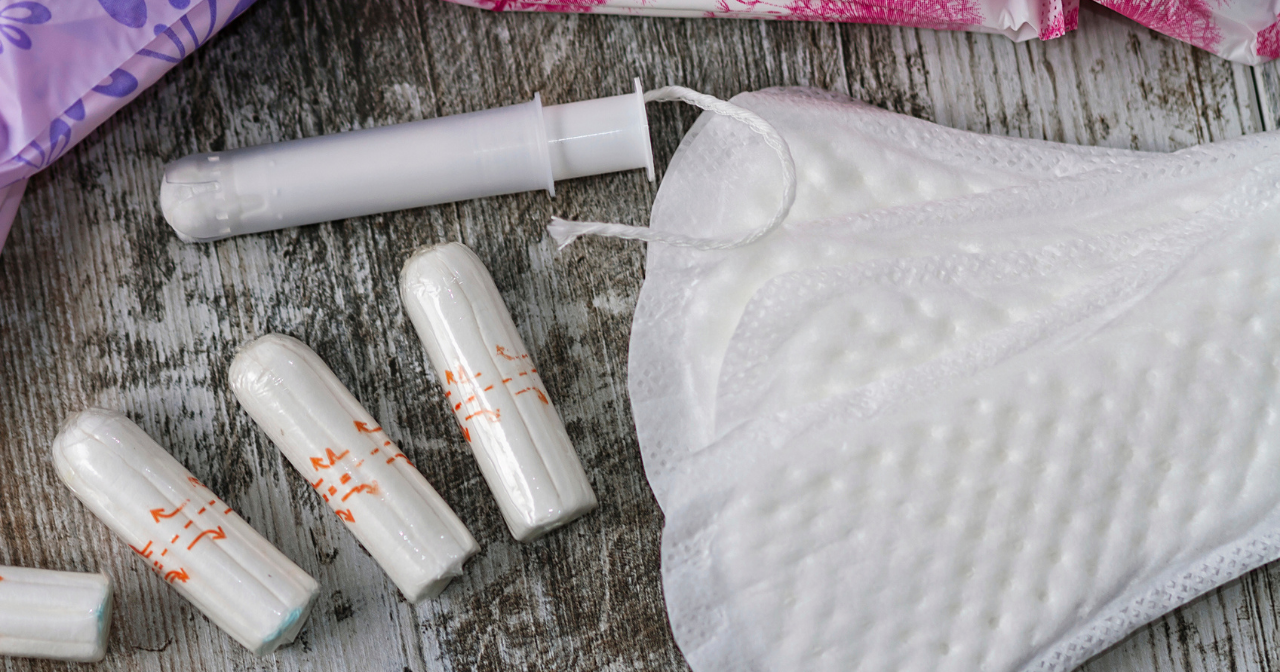We’re Here to Talk Periods
Periods are something that mostly everyone gets. Most begin their period around 12 years old and experience periods for a significant amount of time in their lives. If you haven’t started your period yet and want to know what products are out there, or you are looking for new period products to try out, you’ve come to the right place! The number of period products continues to expand, and we have composed a useful list of the pros, cons, and price for each.
Sanitary Pads
Pads are one of the most common forms of menstrual products on the market right now. They attach to the inside of your underwear and have layers of material to absorb your flow. The material is usually made of cotton, plastic, and rayon. Although most pads are disposable, reusable pads are also available. Reusable pads not only save you a monthly trip to the store, but they are also washable, reusable (hence their name), and you can even double up on them for those heavier days!
Proper Use:
- First, you should find which size matches your flow. In one period cycle, you can use multiple sizes of pads because your flow can change over the course of your cycle. Pads come in many different sizes ranging from thin (pantyliners), regular, and maxi (super). Make sure you use whatever size is comfortable to you!
- Next, using the sticky strap on the back of the pad, stick the pad onto your underwear. If your pads have wings, place the wings on the outside of your underwear to ensure that the pad is secure.
- If you have a reusable pad, some can be held in place with either snaps, or the elastic in your underwear. It all depends on the brand of reusable pads you’re using.
- Be sure to change your pads every 2-4 hours, or when it’s soaked with blood.
- Wrap your used pads in the wrapper it came from or use toilet paper and toss it in the trash.
- Never flush used pads or wrappers down the toilet or it will clog up!
Pros:
- They come in many different sizes to accommodate changes in your flow or activities.
- They can be worn overnight.
- Reusable pads are more environment friendly.
- They don’t disturb your vaginal pH.
Cons:
- They can shift out of place or wrinkle up when you’re moving.
- You can’t swim in them.
- They aren’t discreet when it comes to changing them.
- Disposable pads can be bad for the environment.
Estimated Cost:
Pads can average between $2-$7 per box.
Tampons
Tampons are another common period product and are designed to be inserted into the vagina with or without an applicator. They are used to absorb your menstrual flow during your period. FDA-approved tampons are made of rayon, cotton, or a blend of both. There are also some reusable tampons out there, but the FDA discourages their use because they may carry risks of yeast, fungal, and bacterial infections.
Proper Use:
- First, make sure to wash your hands and get into a comfortable position, inserting a tampon in your vagina is a lot more comfortable when you’re relaxed.
- Next, push the tampon into your vagina using either the applicator or your finger, depending on the type of tampon you have.
- Using a tampon with a smooth rounded applicator or lubricant on the tip of the tampon may be easier for you.
- Be aware, you don’t have to do this alone! If you’re having trouble, you can ask someone you trust such as your mother, sister, or anyone who has experience with tampons to show you how to insert it.
- Do Not flush the wrapper and applicator down the toilet. Throw the wrapper and applicator in the trash.
- Be sure to change your tampon every 4-8 hours. If you plan on wearing your tampon overnight, put it in right before bed and change it as soon as you wake up in the morning.
- When you’re ready to remove it, gently pull the tampon out using the string on one end that hangs out your vagina.
- Wrap your used tampons in toilet paper and dispose of them in the trash- Do Not flush used tampons!
Pros:
- You can swim in tampons.
- Unlike pads, tampons have no visibility.
- You can wear any underwear or clothes you like.
- Tampons are a lot more compact and discreet. They are also easier to dispose of.
Cons:
- Higher risk of Toxic Shock Syndrome (TSS) compared to other methods.
- Can be difficult to use for some.
- Not eco-friendly.
- It can be hard to tell when to change it because it isn’t visible during usage.
Estimated Cost:
Tampons can average $2-$6 per box.
Menstrual Cups
Menstrual cups are small latex or silicone cups. They work by being folded and inserted internally into the vaginal wall where they collect blood. The cup uses suction to create a seal between your vaginal canal and the rim, and they can last up to a decade! This makes menstrual cups not only cost effective, but one of the most eco-friendly period products to exist right now.
Proper Use:
- First, make sure you wash your hands before the application.
- Next, apply water or any lubricant of your choice to the rim of the cup.
- Tightly fold the cup in half (like a taco) with one hand and the rim facing up.
- Insert the cup, making sure the rim is facing up. It should sit a few inches below your cervix.
- Rotate the cup once it is in your vagina, when you rotate the cup, it springs open to create an airtight seal that stops leaks.
- Depending on your flow, your cup can last up to 12 hours.
- To remove, place your thumb and index finger into the vagina and gently pull the stem of the cup until you reach the base.
- Pinch the base to release the seal and pull the cup down to remove.
- When it’s out, empty the cup into the toilet.
- Be sure to thoroughly wash and wipe your cup clean with a gentle soap before reuse.
- Throw away disposable cups after removal.
Pros:
- Cost friendly- once you buy one, you won’t have to buy another for a while depending on proper care.
- Provides long-lasting protection.
- Potentially may reduce cramps.
- Prevents unpleasant odor.
Cons:
- Can be messy and tricky to insert, remove, and clean.
- Requires special cleaning and storage.
- Prone to discomfort.
- Also higher risk of Toxic Shock Syndrome (TSS) compared to other methods.
Estimated Cost:
Menstrual cups can average between $13-$25 per cup.
Menstrual Discs
Similar to menstrual cups, menstrual discs collect your blood instead of absorbing it. They are made from a medical-grade polymer that heats up inside your body and molds to your unique body shape. Menstrual discs rest at the base of your cervix and unlike the cup, discs are for single-use only.
Proper Use:
- Start by washing your hands before inserting.
- Get into a comfortable position making sure you’re relaxed.
- Squeeze the sides of the disc together almost making it the size of a tampon.
- Insert the pinched disc back into your vagina pointing down (sit at a vertical angle so that it completely covers your cervix).
- Make sure it is past the pubic bone or as far as it can go to ensure the rim is tucked above the bone.
- Depending on your flow, a menstrual disc can last up to 12 hours.
- To remove, wash your hands and sit on the toilet (discs can be very messy).
- Reach into your vagina with your index finger, hook it under the rim, and pull the disc straight out.
- Empty the contents into the toilet, wrap the disc in toilet paper, and toss it in the trash. Do Not flush used discs!
Pros:
- You can leave it in during intercourse.
- Little to no risk of slippage.
- They can sometimes auto-dump and hold a higher capacity.
- Can possibly help minimize cramps.
Cons:
- Not cost or eco-friendly.
- Discs have fewer brand and size options.
- Can be messier to remove.
- May cause vaginal irritation.
Estimated Cost:
Menstrual discs can cost between $10-$20 for a pack of 8-12 discs.
Period Underwear
This particular product is new to the scene and they’re starting to become a game changer! Period-proof underwear have multiple thick microfiber polyester layers that are absorbent and prevent leakage. Some resemble regular underwear, they’re washable, and a good quality pair can prevent odor.
Proper Use:
- Wear your period underwear when you’re bleeding.
- The same way you wash your regular underwear, you can do the same with your period underwear!
- Your underwear will come with instructions on the best way to wash them, which will vary by brand.
- Whether you have a light or heavy flow, you may need to change your period underwear more than once a day, or you can even wear a pad, tampon, etc. to help with your flow.
Pros:
- They are reusable and have a minimal environmental impact.
- They can sometimes hold the amount of blood a couple of tampons could.
- Great for overnight protection.
- They come in different styles and absorbency levels.
Cons:
- Can be awkward to change in public.
- Depending on the brand or how long you wear them, they can start to smell.
- Can be uncomfortable for people who don’t normally wear pads.
- Can be very expensive.
Estimated Cost:
Period-proof underwear can range from $24-$65 per pair.
Periods are something that some people dread during their time of the month, but it shouldn’t have to be! It is important that you find what period products(s) work for you. Helping Women Period provides resources for individuals who have trouble affording their preferred period products. If you feel comfortable enough, you can also share your experiences with people who may just be starting their period or have little knowledge on the options that are available. Be sure to also talk with your health care provider or someone you trust to see what option would be best for you and your health. You should never have to suffer when you’re on your period! Learn what works for you, your uterus will thank you for it.
Emani Brooks is a senior at Suitland High School in Maryland. She currently is the President of the Suitland National Honor Society Chapter for the class of 2022. Emani plans to study Business Administration upon graduating high school and hopes to pursue a career in social media management.



